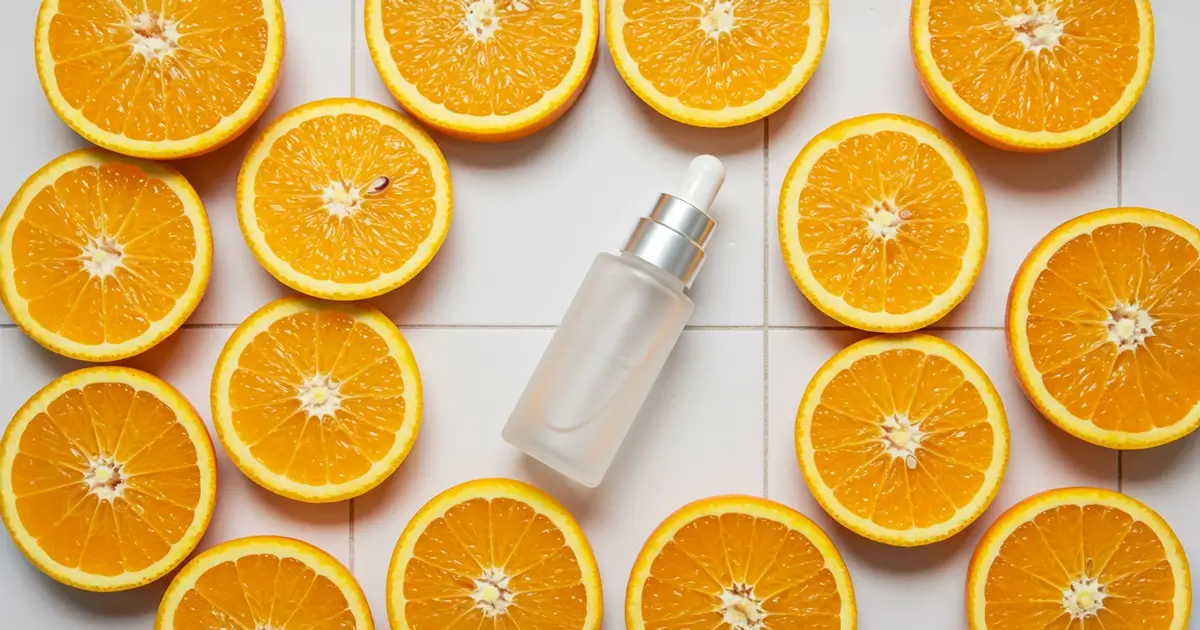Vitamin C is a superstar antioxidant, yet it spoils faster than last week's kale salad. Today I unpack how scientists tame its fickle nature, so your serum keeps delivering bright-skin and firm-skin benefits. Ready for a 12-minute read?
Why Vitamin C Needs a Bodyguard
Pure l-ascorbic acid is powerful, but it oxidises fast when exposed to air, light, or warmth. Oxidised Vitamin C not only loses efficacy, it can even trigger irritation. That is why smart stabilisation matters more than the percentage printed on the bottle.
Oxidation begins the second a dropper meets oxygen. Colour shifts from clear to amber give the game away, yet potency falls long before the hue deepens. Formulators fight this by tweaking pH, adding supportive antioxidants, and sealing the formula away from UV.
Solubility adds another hurdle. Vitamin C prefers water, yet many skin-friendly carriers are oil based. Bridging that gap without raising pH calls for inventive chemistry and sometimes a dash of surfactant magic.
Enemies: Oxygen, Light, Heat
Oxygen cleaves Vitamin C's fragile electron structure, light accelerates that process, and heat speeds both reactions. Imagine your serum as an unpeeled orange: once sliced, air and sun dry it out quickly, so darkness and cool storage become essential.
Laboratory tests show that a 10-degree Celsius rise can double oxidation rate, making your steamy bathroom a stealth villain in the potency plot.
Forms of Vitamin C
Besides l-ascorbic acid, chemists use derivatives like sodium ascorbyl phosphate or 3-O-ethyl ascorbic acid. These molecules trade some immediate kick for longer shelf life. Enzymes in the skin convert them to active Vitamin C, though conversion rates vary.
Magnesium ascorbyl phosphate shines in sensitive routines because it works at neutral pH. However, its collagen-boosting data lags behind pure l-ascorbic. Trade-offs are inevitable, so knowing your skin's tolerance helps pick the right form.
Formulation Strategies That Work
Stability starts with acidic pH around 3.2. At this level, l-ascorbic remains protonated and less reactive, yet the formula must still feel pleasant, not sting. Buffers like sodium citrate help hold that pH steady throughout the product's life.
Additive antioxidants create a sacrificial shield. When paired with 1 % Vitamin E and 0.5 % ferulic acid, Vitamin C enjoys dramatically longer activity. A classic 2005 study showed that the trio doubled photoprotection compared with Vitamin C alone.
Water activity also matters. Removing free water via anhydrous bases or micro-encapsulation deprives oxidising reactions of their favourite playground. Encapsulated particles burst only on contact with the skin's moisture, delivering fresh Vitamin C every morning.
pH Control and Chelators
Chelators like disodium EDTA bind metal ions that catalyse oxidation. Combined with low pH, they create a hostile environment for free radicals. Think of them as tiny bouncers escorting trouble-making metals out of the dance floor.
For DIY enthusiasts tempted to sprinkle ascorbic powder into tap water: please don't. Municipal water contains iron ions that speed up degradation, leaving you with rusty-orange toner in days.
Antioxidant Synergy
Ferulic acid donates an electron before Vitamin C must, preserving its structure. Vitamin E protects lipid domains, so the trio covers both water-loving and oil-loving areas of your skin barrier. Synergy delivers protection bigger than the sum of parts.
Recent family-medicine guidelines highlight that adding ferulic acid boosts UV defence by almost eightfold compared with Vitamin C alone (ACOF P 2024 review).
Encapsulation Techniques
Liposomal and niosomal systems wrap Vitamin C in double-layered bubbles. This not only guards against oxidation but can also improve skin penetration, though the jury is still out on how deep these carriers travel.
Polymer-based micro-sponges release Vitamin C slowly over hours, a gentle option for easily flushed cheeks. And no, you don't need to tape orange slices to your face - science has upgraded our delivery methods.
Packaging, Storage, and Daily Handling
Even the most elegant formula flops without clever packaging. Amber glass blocks most UV light, but air still sneaks past dropper threads. Airless pumps reduce headspace and limit each dose's contact with oxygen.
Opaque aluminium tubes score highest on light exclusion, yet they can be prone to crimp leakage after repeated rolling. Hybrid solutions pair plastic linings with protective outer shells for a middle-ground fix.
At home, think of your serum as milk rather than perfume: store it cool and use it within three months of opening. A crisp fridge shelf works wonders and will not dull potency, according to dermatologists cited by Mayo Clinic.
Smart Bottles and Airless Pumps
Modern airless pumps collapse an inner pouch as you dispense product, preventing oxidation. They also give you that last satisfying click when the chamber empties, so nothing lurks wasted in corners.
If you prefer droppers, pick a 15 ml size over the showy 30 ml bottle. Smaller volume means fewer weeks of oxygen exposure and a better chance of finishing while still fresh.
Home Storage Hacks
Keep serums away from bathroom humidity and daylight. A bedroom vanity drawer or skincare fridge around 8 °C slows degradation noticeably. Just ensure lids close firmly each time; loose caps are sneaky saboteurs.
When travelling, wrap the bottle in foil or stash it inside a dark sock. It may look odd at airport security, yet the serum arrives un-tanned and effective.
Choosing and Using the Right Serum
Scan ingredient lists for l-ascorbic acid near the top, pH disclosure, and supporting antioxidants. Avoid formulas that list fragrance ahead of stabilisers; pretty scent should never outrank potency.
Reputable brands disclose percentage and pH, sometimes publishing stability data. A quick email to customer service can reveal details hidden from the label. Transparency often signals better research budgets.
Application timing depends on your routine. Morning use under broad-spectrum sunscreen reinforces UV defence; evening use pairs nicely with peptides. Whichever you choose, consistency beats sporadic high doses.
Ingredients to Look For
Besides ferulic acid and Vitamin E, look for glutathione, resveratrol, or low-weight hyaluronic acid that hydrates without raising pH. Silicones like dimethicone form a light seal, reducing oxygen influx during wear.
If you see "water, ascorbic acid, fragrance" as the opening trio, step away. The pH is likely too high, and perfume adds sensitising risk.
Patch Testing and Layering
Test behind the ear for three consecutive nights before full-face use. Slight tingling is normal, but stinging or redness that lasts beyond ten minutes signals a formula mismatch.
Layer Vitamin C on freshly cleansed, damp skin, wait sixty seconds, then add hydrating serum or moisturiser. Acids like glycolic can follow in a separate routine night to avoid overwhelming the barrier.
Tracking Results
Take photos in the same light every two weeks. Look for fading hyper-pigmentation and a more even tone around cheeks. Firmness changes are subtler; press the skin next to the mouth to feel bounce over time.
Remember to compare new images, not memory alone. Our brains adjust quickly, underplaying gradual improvements.
FAQ
Can I mix Vitamin C powder into my night cream?
You can, yet controlling pH and metal ions at home is tricky. The mixture may oxidise within days, wasting product and money.
Does higher concentration mean better results?
Not necessarily. Most studies show diminishing returns above 20 %. Stability and delivery trump brute force percentages.
Should I store my serum in the fridge?
Yes, a cool environment slows oxidation. Just keep it away from food odours and always seal the cap tightly.
Can I use Vitamin C with retinoids?
You can alternate: Vitamin C in the morning, retinoid at night. Using both together often irritates sensitive skin.
Why does my serum turn brown?
Browning signals oxidation. Discard if it smells metallic or differs sharply from its original colour.
Conclusion
A stable Vitamin C serum is the product of low pH, supportive antioxidants, smart packaging, and mindful storage. Understanding these factors lets you pick a bottle that truly brightens and firms.
Drop any questions below and let me know how your current serum stacks up. See you in the next post - until then, take good care of your skin!


Comments (0)
No comments yet - be the first to share your thoughts!
Leave a Reply
Your email address will not be published. Required fields are marked *